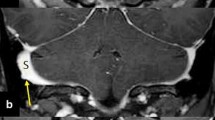Abstract
The author studied a superficial temporal vein running anteroposteriorly within the occipitotemporal sulcus, the “occipitotemporal vein”, which, when prominent, could be thought to simulate a “venous angioma” on MRI. A cadaver (n=50), MRI (n=200), and CT (n=50) study was undertaken to examine the incidence, detectibility, size, location, and drainage of the occipitotemporal vein. It was an approximately 3 mm wide, 2–5 cm long structure. It was present in 83% of the cadavers (52% bilaterally), and clearly identifiable on 73% of the MRI (43% bilaterally), and 8% of the CT studies. In 18% of the cadavers the vein was totally absent, and it was not seen in 27% of the MRI examinations. The occipitotemporal vein can be distinguished from a venous angioma by its particular location and course, and by lack of intraluminal bright signal on spin-echo T2-weighted and/or contrast-enhanced T1-weighted images. In addition, venous angiomas are usually intraparenchymal, whereas the occipitotemporal vein is a superficial vessel.
Similar content being viewed by others
References
Williams PL, Warwick R, Dyson M, Bannister LH (1989) Gray's anatomy. 37th edn. Churchill Livingstone, Edinburgh, p 798
Figge FHJ (1963) Atlas of human anatomy, 8th edn. vol 3, part 2. Hafner, New York, figs 209, 210, 251, 255
Meschan I (1975) An atlas of anatomy basic to radiology, 1st edn. Saunders, Philadelphia, p 372
Uchino A, Hasuo K, Matsumoto S, Furukawa T, Matsuura Y, Fujii K, Fukui M, Masuda K (1992) MR imaging and angiography of cerebral venous angiomas associated with brain tumors. Neuroradiology 34:25–29
Uchino A, Imada H, Ohno M (1990) Magnetic resonance imaging of intracranial venous angiomas. Clin Imag 14:309–314
Augustyn GT, Scott JA, Olson E, Gilmor RL, Edwards MK (1985) Cerebral venous angiomas: MR imaging. Radiology 156: 391–395
Wilms G, Demaerel P, Marchal G, Baert AL, Plets C (1991) Gadolinium-enhanced MR imaging of cerebral venous angiomas with emphasis on their drainage. J Comput Assist Tomogr 15:199–206
Runge VM (1990) Clinical magnetic resonance imaging, 1st edn. Lippincott, Philadelphia, pp 66–77
Author information
Authors and Affiliations
Rights and permissions
About this article
Cite this article
Sener, R.N. The occipitotemporal vein: a cadaver, MRI and CT study. Neuroradiology 36, 117–120 (1994). https://doi.org/10.1007/BF00588074
Received:
Accepted:
Issue Date:
DOI: https://doi.org/10.1007/BF00588074




